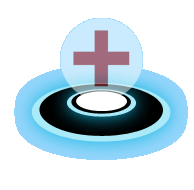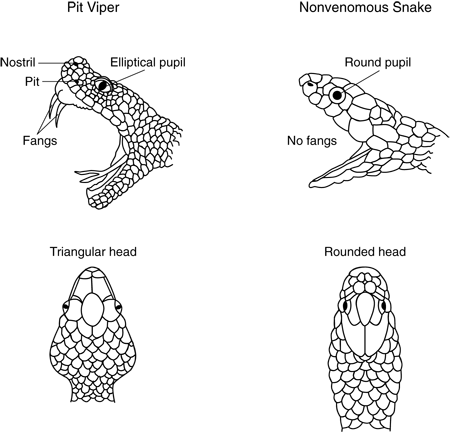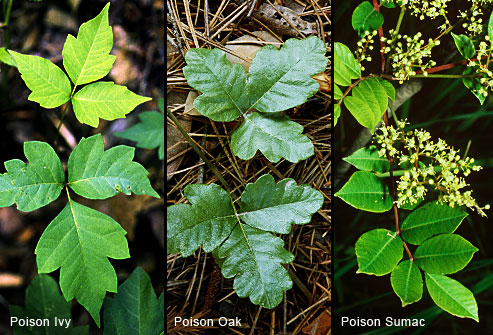
|

|
First Aid - Bites, Stings, and Plants
|

|








|
|
Let's face it, there are things in this world that would love to make a meal out of you.
Or maybe they just want to protect themselves.
Whether they are animals or insects, certain bites and stings can cause serious illness or even death in people who are sensitive to the venom.
|
Insect Stings
Most of the time, insect stings are harmless to people.
However, for those that are allergic, an insect sting can lead to anaphylactic shock, a life-threatening situation.
Signs of anaphylaxis include a rash, tightness in the chest and throat, and the swelling of the face, neck and tongue.
Dizziness and confusion is also possible.
People who know they are allergic to certain substances or insect stings may carry medication to reverse the allergic reaction (e.g., antihistamine pills, Epi-Pen).
Signs of an insect sting include a stinger, pain, swelling, and signals of an allergic reaction.
Treatment:
- Remove any visible stinger by scraping it away from the skin with a plastic card.
Tweezers can also be used (be sure to grasp the stinger and the the venom sac).
- Wash the site with soap and water.
- Cover the injury and keep it clean.
- A cold pack can be applied to reduce pain and swelling.
- Call 911 or the local emergency number if the person has trouble breathing or if signs of anaphylactic shock is present.
|
Animal Bites
The bite of a domestic or wild animal can cause infection and soft tissue injury.
The most serious possible result of an animal bit is rabies.
This viral disease is transmitted through the saliva of diseased animals.
Rabid animals may drool, appear to be partially paralyzed, or act aggressively or strangely quiet.
Rabies can be fatal if not treated.
If the animal is suspected of carrying rabies, do not try to catch the animal or come in contact with the animal's saliva.
Get the person to medical attention.
Treatment:
- For severe animal bites, call 911 or the local emergency number.
- Control the bleeding as much as possible.
- Do not clean serious wounds.
- If bleeding is minor, wash the wound with soap and water and run clean water over it.
- Apply an antibiotic ointment and cover with a dressing.
- Watch for signs of infection.
|
Marine Life Stings
The stings of marine life are not only painful, but they can make you sick or worse, kill you.
Side effects can include allergic reactions as well as paralysis and death.
Signs of marine life stings include possible puncture marks, pain, swelling, and possible signs of allergic reaction.
Treatment:
- Call 911 or the local emergency number.
- Get the lifeguard to remove the person away from the water as soon as possible.
- Avoid touching the person with your bare hands; you can be exposed to the stinging tentacles.
- If the sting is from a jellyfish, irrigate the injured part with vinegar as soon as possible for 30 seconds.
If the sting is from a bluebottle jellyfish (Portuguese man-of-war), use ocean water.
- Do not rub the wound, apply pressure, or fresh water; this may increase pain.
When stinging ceases, have the person take a hot shower for 20 minutes.
For stings from stingray, sea urchin, or spiny fish, flush the wound with tap water or ocean water.
- Keep the injured part still and soak in hot water for 20 minutes. Hot sand may also be used.
- Clean the wound and apply a bandage.
- Monitor for signs of infection.
|
Ticks
Ticks can carry diseases such as Rocky Mountain spotted fever, Babesia infection, Ehrlichiosis, and Lyme disease.
Treatment:
- When removing a tick from a person's skin, graph the tick with tweezers.
- Get as close to the skin as possible and pull slowly and steadily.
- Ensure that the head of the tick is removed from the skin.
Rocky Mountain Spotted Fever
A bacterial infection spread by ticks.
Mostly occurs in the spring and summer.
Spread by wood ticks in the western United States, dog ticks in the eastern United States, and other ticks in the southern United States.
Symptoms usually appear between 2 and 14 days after a tick bite.
Signs to look for include fever, nausea, vomiting, muscle aches, lack of appetite, headache, rash, abdominal and joint pain, diarrhea.
The rash first appears as small spots on the wrist and ankles.
It will then spread to the rest of the body.
Treatment:
- Call 911 or the local emergency number.
- Treatment consists of antibiotics.
- If left untreated, this can be life-threatening.
Babesia infection
A protozoa infection that is more common during warm months.
Spread by deer ticks and black-legged ticks in the northeast and upper Midwest regions of the United States.
Symptoms may include flu-like ones such as fever, sweats, chills, body aches and headaches, no appetite, nausea, and fatigue.
Some may develop a type of anemia that causes jaundice and dark urine.
Treatment:
- Call 911 or the local emergency number.
- Treatment consists of prescription medication.
Ehrlichiosis
A bacterial infection caused by the Lone Star tick in the southern, eastern and south-central United States.
While many people do not become ill, some develop symptoms five to 10 days after the bite.
Symptoms include fever, headache, fatigue, muscle aches, nausea, vomiting, diarrhea, cough, joint paints, confusion, and rash.
Treatment:
- Call 911 or the local emergency number.
- Treatment consists of antibiotics.
Lyme Disease
A disease that is spread by the deer tick and the black-legged tick and have been reported in all 50 states.
More common between May and late August.
The tick must remain embedded in the human skin for 36 to 48 hours to transmit the disease.
Symptoms include a rash that starts as a small red area at the site of the bite.
It may spread up to seven inches across; it may have a bull's-eye appearance in some individuals.
Other symptoms include fever, headache, weakness, and joint and muscle pain as well as fatigue, fever, stiff neck, tingling or numbness in fingers and toes, and facial paralysis.
Advanced stages of Lyme disease may cause painful arthritis, numbness in the arms, hands or legs, severe headaches, memory loss, confusion, dizziness, and problems seeing or hearing.
Heart problems may also occur.
Treatment:
- Call 911 or the local emergency number.
- Treatment consists of antibiotics.
|
Snake Bites
Most snakebites occur near the home, not in the wild.
Deaths usually occur if the bitten person has an allergic reaction, is in poor health or because too much time passed before medical care is sought.
Symptoms of snake bite includes a bite mark, pain, and swelling.

Treatment:
- Call 911 or the local emergency number if the bite is from a venomous snake.
- Wash the wound and apply an elastic bandage to slow the spread of venom (fingers must not be able to easily be pushed in between the band and the skin.
- Keep the injured area lower than the heart.
- Do not apply ice.
Do not cut the wound.
Do not apply suction.
Do not apply a tourniquet.
|
Spider Bites and Scorpion Stings
The bites of the black widow, brown recluse, and the northwester brown (hobo) spiders can, in rare cases, kill a person.
These spiders prefer dark, out-of-the-way places (e.g., garage, attics, and wood piles) and people are often bitten when reaching into these locations.
Scorpions live under rocks, logs, and the bark of certain trees.
They are most active and night and are difficult to distinguish from poisonous and nonpoisonous scorpions.
To be on the safe side, all scorpion stings should be treated as medical emergencies.
Symptoms of spider bites depend on the amount of venom injected and the person's sensitivity to the venom.
Treatment:
- Call 911 or the local emergency number.
- Wash the wound thoroughly.
- Apply an antibiotic ointment and bandage the wound.
- An ice pack can be applied to reduce the pain and swelling.
- Keep the bitten area elevated.
|
Poisonous Plants
Common poisonous plants that people may come into contact with include poison ivy, poison oak, and poison sumac.
The contact with these plants causes the skin to become itchy, with the possibility of blisters forming.

Treatment:
- Remove any clothing that may have been exposed to the plant.
- Wash the exposed area thoroughly with soap and water as soon as possible after contact.
- Calamine lotion and antihistamines may help relieve the rash.
|
|
|
















